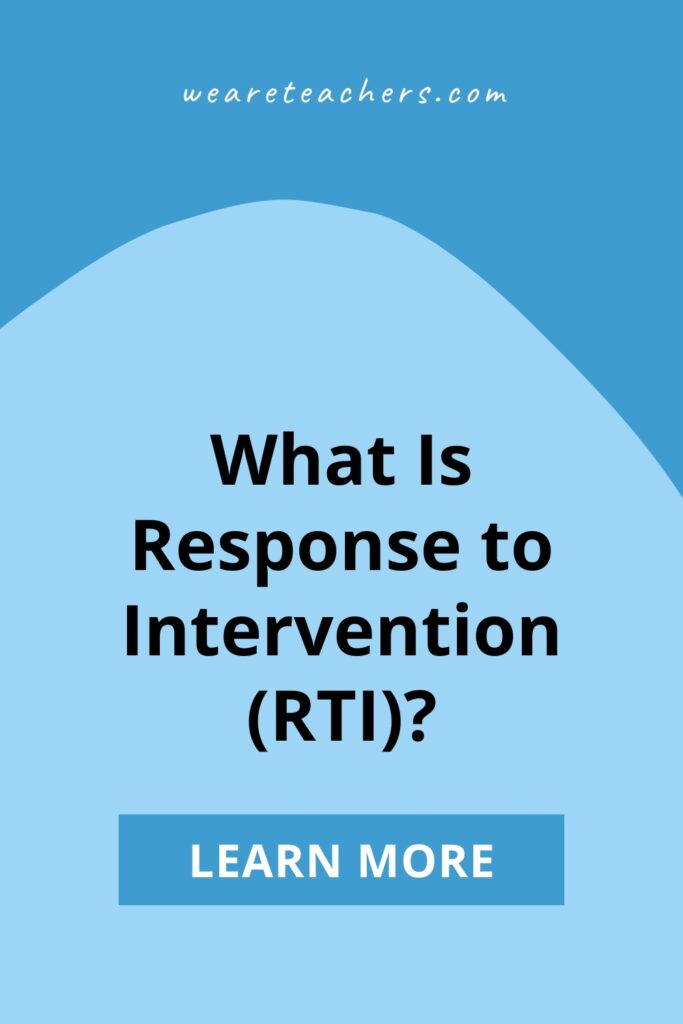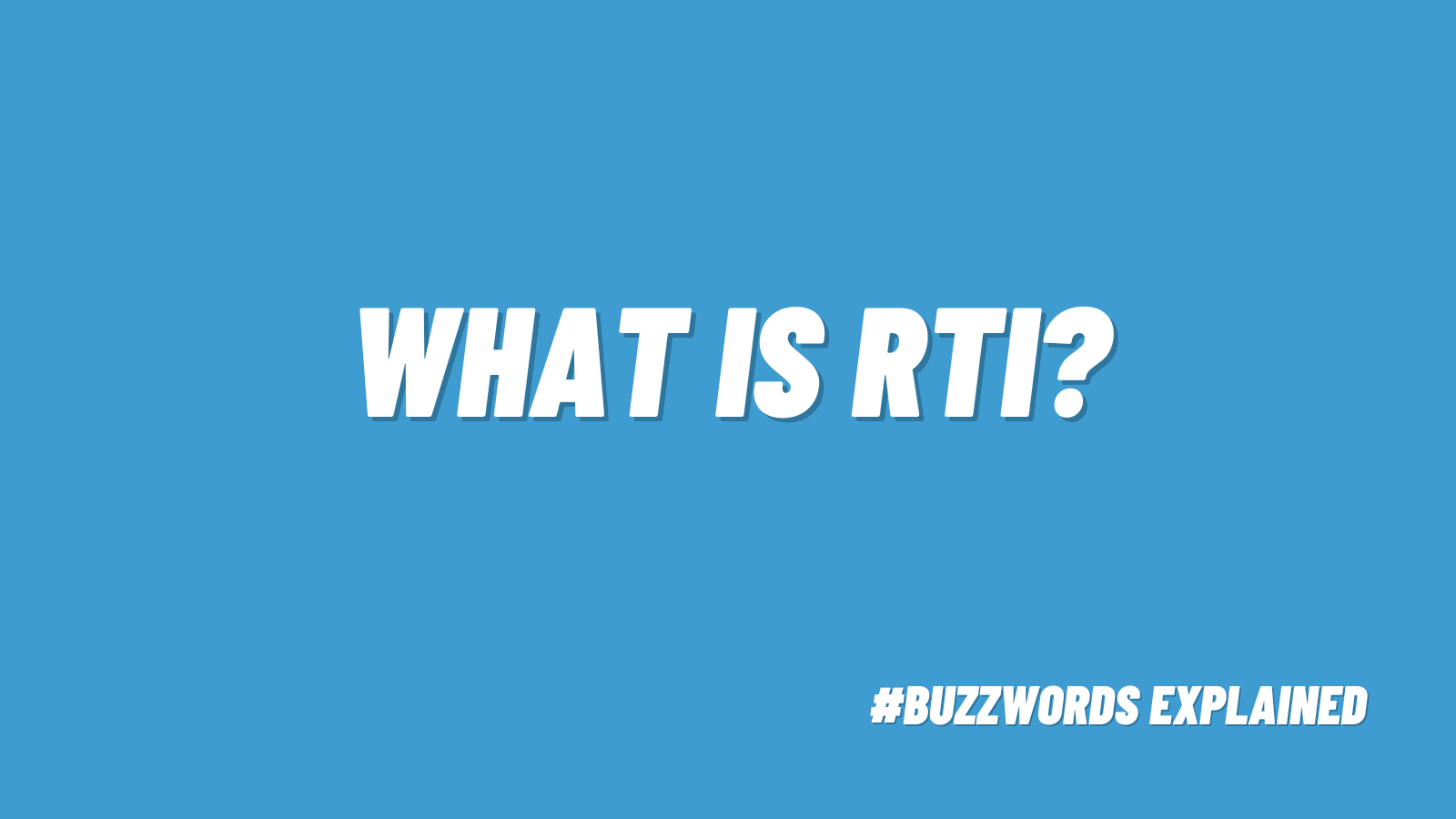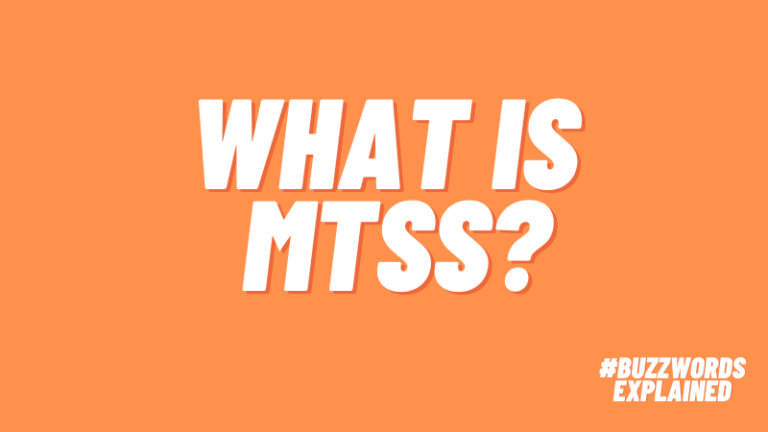Response to Intervention, or RTI, is a way to identify and support students who need extra academic or behavioral help to succeed in school. It is a tiered approach because there are various “levels” of support that students move through depending on how much support they need.
Since RTI started in 2004, it has become best practice (and federal law), so all public schools implement some form of RTI. Here’s everything you need to know about RTI.
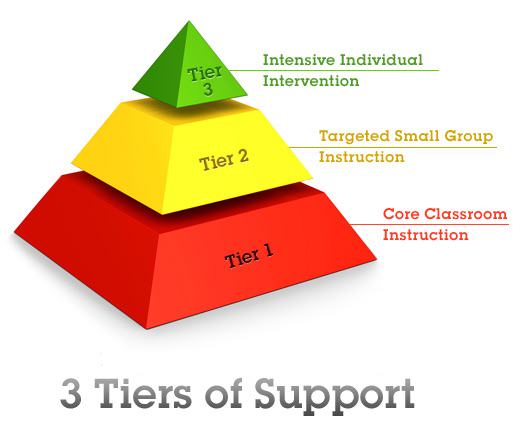
Image: StudySkills.com
RTI in a Nutshell
In short, RTI:
- Uses a tiered approach to delivering intervention.
- Provides early intervention for students who need it.
- Collects and uses data to decide which students move into Tier 2, Tier 3, and special education.
- Increases the use of research-based and evidence-based practices in classrooms.
- Aims to reduce referrals for special education.
The idea is that RTI provides support for students early on, long before they fail. There is no one way to do RTI, except that it has to have tiers. The federal IDEA law (Individuals With Disabilities Education Act) requires schools to apply a tiered approach to address academic and behavior concerns as part of the process to identify students with learning disabilities, though districts can make decisions about how they structure and approach RTI.
Read more: What Is IDEA?
You may also have heard of MTSS, or Multi-Tiered System of Supports, a framework for tiered interventions that includes RTI. Read more here: What Is MTSS?
What happens in each RTI tier?
RTI is tiered, meaning that students are grouped into tiers, typically shown in a triangle.
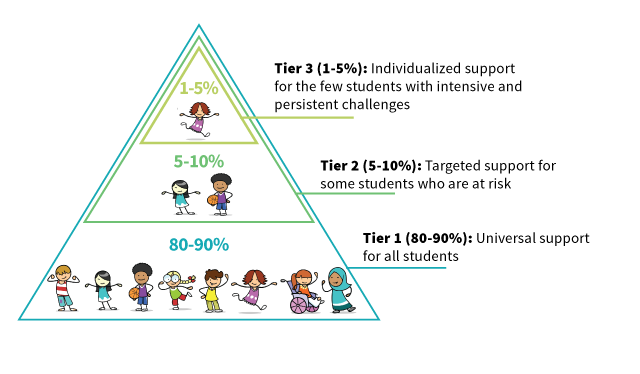
Image: Student Behavior Blog
Tier 1: All students
All students start in Tier 1 instruction, which includes high-quality core instruction and universal screening. Most students stay in Tier 1, and Tier 1 instruction is “effective” when 80% of students are making progress.
For example, in a second grade classroom, a teacher leads students through units in a curriculum that incorporates all the elements of foundational reading instruction—phonics, word reading, fluency, comprehension, and vocabulary. After eight weeks, students are given a universal screening, such as the DIBELS screener. The teacher reviews the data and finds that 80% of their class is mastering core reading skills (word decoding, fluency accuracy and rate). However, five students are not making progress, so these students move into Tier 2.
Tier 2: 10% to 20% of students
Tier 2 interventions are provided by a general education teacher or interventionist. Students work in small groups on a specific skill. Any interventions are given in addition to Tier 1 instruction, not in place of it. Students work in Tier 2 for a set period of time, often 8 to 10 weeks, and are given progress-monitoring assessments to track their progress.
In our example, five students are identified for fluency intervention. These five students work in a small group with their teacher three times a week (while the rest of the class is reading independently). They practice reading passages and use strategies like reviewing phonics patterns, rereading sentences and passages, and partner reading. During the intervention, they are given a fluency prompt every two weeks. Using this data, the teacher sees that three students have made expected progress and have met their goals; two have not. The three students who have made progress are exited from intervention and are back in Tier 1, while the two students who have not made progress are moved to Tier 3.
Tier 3: 1% to 10% of students
In Tier 3, students work with an interventionist or special education teacher. The teacher provides intensive, individualized intervention that focuses on the student’s skill deficits. Students who do not make progress in Tier 3 may be referred for an evaluation to see if they are eligible for special education services.
In our example, the two students who have not made progress are moved to Tier 3. They work with a reading interventionist who uses explicit instruction to reteach phonics patterns they missed and uses the HELPS reading program, an evidence-based program aimed at improving reading fluency. After six weeks of intervention, one student has shown progress and moves out of Tier 3. The other student is referred for an evaluation for special education services.
Check out HELPS (Helping Early Literacy With Practice Strategies).
What is universal screening?
Universal screenings are assessments given to all students to track their progress. A universal screener provides information about how each student is performing based on what has been taught and in relation to peers or how they are expected to progress. Universal screeners are given set points during the year—typically in fall, winter, and spring. After a few assessments (typically three), teachers can review student data across multiple data points and determine which students are making adequate progress and which require intervention.
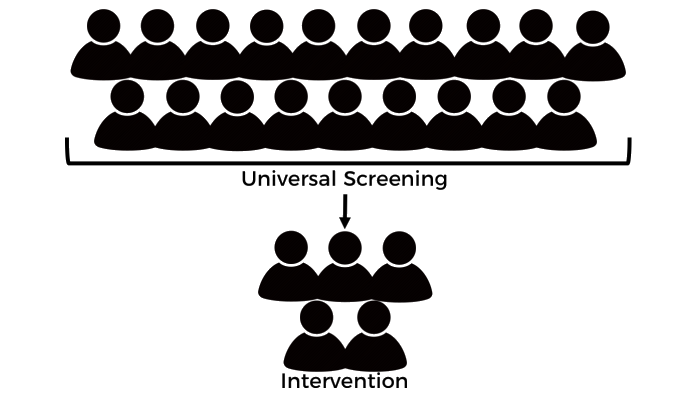
Image: SEBA
Teachers use information from universal screeners to understand which skills students have mastered, as well as what to reteach. For example, if 50% of a class has not mastered adding fractions, then the teacher knows to reteach that skill to the whole class.
There are two main types of universal screeners: criterion-referenced and norm-referenced.
- Criterion-referenced measures have benchmarks that identify expected skill levels for students by grade. The Vanderbilt University Word Identification Fluency (WIF) measure is a test that helps determine if students are “on level” at the start of first grade. If a student reads 15 words correctly in one minute, they are “on level,” or have met the benchmark.
- Norm-referenced measures have standard scores or percentile ranks that compare students with peers across the country. The NWEA/MAP assessment, or a standardized achievement test score, is a norm-referenced measure.
After a universal screening is completed, teachers can rank students according to score—highest to lowest—and select the bottom 10% to 20% for intervention. Or teachers can set a cut score for intervention, say, the students who have fallen below 15 on the Vanderbilt WIF measure. The important thing is having a process with a clear rationale for choosing which students receive intervention.
What are some universal screening assessments?
Universal screening assessments should be quick and easy to administer, and they should produce helpful information. Some screeners for reading are:
- Curriculum-based measurements like the DIBELS early literacy skills test (free)
- Dolch sight word lists
- Standardized reading assessments like Woodcock Reading Mastery Test (WRMT-R)
- Online assessments like NWEA/MAP or iReady
Whichever test or combination of tests is given, teachers will gauge how students are mastering skills and get information about what they’re missing. Data about a student’s errors lets teachers focus on the skills to reteach.
Read more: What are reading levels?
What are evidence-based interventions?
One core idea behind RTI is that students who struggle with a skill like reading won’t catch up unless they are given strong intervention. Interventions in RTI should be evidence-based and provide more efficient instruction and more practice at the skills the student is struggling with.
Once a student is in Tier 2 or Tier 3, they should be receiving evidence-based interventions. These are strategies or full programs that have been tested by researchers and shown to produce gains in specific skills. For example, Sound Partners, a phonics and word reading intervention, has shown how to increase alphabetics, fluency, and comprehension in students in grades K-1. So, you may choose Sound Partners for students who need extra support in those areas.
Find resources for evidence-based practices at these websites:
- Best Evidence Encyclopedia
- What Works Clearinghouse
- National Center on Intensive Intervention
- The CEEDAR Center
- Evidence Based Intervention Network
What are the different ways to implement RTI?
There are two main approaches to RTI: problem-solving and standard protocol.
Problem-Solving
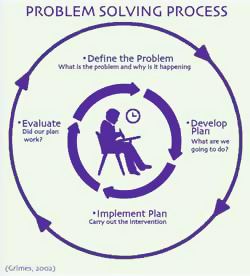
Image: IRIS Center
In this approach, teachers:
- Define the problem.
- Create a plan.
- Implement the plan.
- Evaluate the results.
Teachers have more influence and decision-making ability in the problem-solving approach. In fact, the ultimate effectiveness of the interventions depends on the expertise of the teacher. However, fidelity is more difficult with this approach and needs to be closely monitored.
Standard Protocol
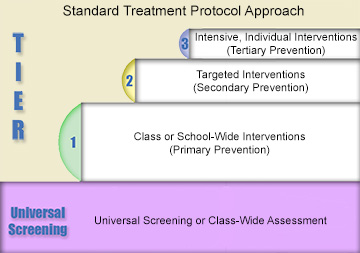
Image: IRIS Center
The standard protocol approach (or standard treatment protocol) is a more prescribed approach. Each student who demonstrates a specific difficulty will receive the same intervention. So, all students who have trouble with behavior would receive the same interventions.
In the standard protocol approach, implementation is easier to maintain and track because the interventions are set ahead of time. And it’s less dependent on teacher skill. A variety of support staff can administer interventions because they are standardized, as long as there is oversight.
How is progress monitored?
When a student is in intervention, teachers track their performance and learning rate. For example, a list of letters and words may be used to track how much progress a child is making in learning letter sounds and reading CVC words. Then, that information will be used to decide: Is the student making sufficient progress to quickly move back into Tier 1? Or are they making slow or no progress and need additional intervention in Tier 3?
Another aspect of progress monitoring is fidelity, or closely ensuring the intervention is being followed in accordance with what was planned. For example, if an intervention should be implemented three times a week for 20 minutes per session, covering one lesson each session, the intervention teacher collects data to show whether the intervention was administered as planned. Then, teachers use fidelity data to help decide what to do next. If an intervention was not implemented with fidelity, maybe because a student was absent for more than 20% of the time, they may decide to continue to provide the Tier 2 intervention but also get parents involved to increase attendance.
How is RTI connected to special education?
Before RTI, students were identified as having a learning disability if their IQ was higher than their achievement. Now, RTI has replaced the IQ-achievement discrepancy model in many states. So instead of using a child’s IQ and achievement scores to determine if a child is eligible for special education services, the IEP team looks at the interventions a student has received and whether or not they are making expected progress in those interventions.
Put another way, RTI is not special education. It is, however, part of the process for determining if a student has a learning disability. When an IEP team is deciding if a child is eligible for special education, progress-monitoring data will play an important role.
Read more What Is Special Education?
How are parents involved in RTI?
Parent involvement is an important part of RTI. This means inviting parents to RTI meetings, informing them about interventions and how students are moving through tiers, and letting them know when their child has exited RTI or if they are moving into a special education referral. Essentially, parents are partners in the process, though each school will handle this differently.
More RTI Resources
Vanderbilt IRIS Center: RTI Module
Intervention Central RTI Resources
Do you have questions about RTI or any other education topics? Connect with other teachers in the WeAreTeachers HELPLINE group on Facebook.
For more articles like this one, be sure to subscribe to our newsletters to find out when they’re posted!
